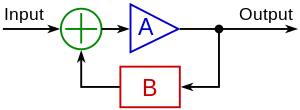PDC
Schmitt trigger
In electronics, a Schmitt trigger is a circuit with positive feedback and a loop gain greater than 1. The circuit is named a "trigger" because the output retains its value until the input changes sufficiently to trigger a change. In the non-inverting configuration, when the input is higher than a certain chosen threshold, the output is high. When the input is below a different (lower) chosen threshold, the output is low, and when the input is between the two levels, the output retains its value. This dual threshold action is called hysteresis and implies that the Schmitt trigger possesses memory and can act as a bistable circuit (latch). There is a close relation between the two kinds of circuits: a Schmitt trigger can be converted into a latch and a latch can be converted into a Schmitt trigger.
Schmitt trigger devices are typically used in open-loop controller configurations for noise immunity, and closed loop negative feedback configurations to implement bistable regulators, triangle/square wave generators, etc.
Implementation
Fundamental idea
Circuits with hysteresis are based on the fundamental positive feedback idea: any active circuit can be made to behave as a Schmitt trigger by applying a positive feedback so that the loop gain is more than one. The positive feedback is introduced by adding a part of the output voltage to the input voltage; so, these circuits contain an attenuator (the B box in the figure on the right) and a summer (the circle with "+" inside) in addition to an amplifier acting as a comparator. There are three specific techniques for implementing this general idea. The first two of them are dual versions (series and parallel) of the general positive feedback system. In these configurations, the output voltage increases the effective difference input voltage of the comparator by decreasing the threshold or by increasing the circuit input voltage; the threshold and memory properties are incorporated in one element. In the third technique, the threshold and memory properties are separated.
